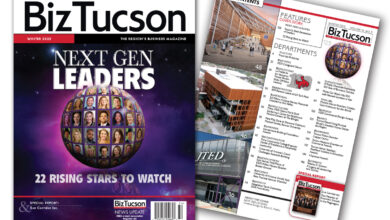
The Refinery Opens
New Commercial, Academic Hub at UA Tech Park at The Bridges
By April Bourie
The long-anticipated University of Arizona Tech Park at The Bridges, located on Kino Parkway and Interstate 10, will open its first building known as The Refinery in late January. The Refinery’s 120,000 square feet of office space will be shared equally by UArizona programs and outside businesses wanting to work closely with the university.
The first university program moving into The Refinery is UArizona Applied Research Corporation. It is a separate 501(c)(3) organization that provides products, services and solutions to national security challenges in the U.S. government and industry. Moving into their new spaces in The Refinery in late March will be Tech Launch Arizona, the university’s tech transfer licensing office which moves inventions from university research and technological innovation into the marketplace, and Research, Innovation and Impact (RII), the office responsible for supporting more than $734 million in research activity at UArizona.
The Refinery will also house UA Online, the university’s online educational program, so that all of its staff and professors are headquartered in one location with a focus on growth.
A regional outpost for the UArizona Center for Innovation will open in The Refinery. UACI is an incubator network for science and technology startup companies both from inside and outside UArizona. UACI is headquartered at the UA Tech Park, Rita Road and Interstate 10, and has outposts across the region, including a bioscience incubator in Oro Valley.
UACI guides startups through a 27-point program that helps them refine their products and offerings, find success in their product launch and gain sustainability. The program has successfully assisted over 160 startups since its inception in 2003. There are currently a total of 58 startup companies in the program – the highest concentration of startups in any incubator program in Arizona, according to Carol Stewart, associate VP of Tech Parks Arizona.
Several businesses are waiting to get into the UACI program and the bioscience incubator, the latest place to open, is full. Opening the additional regional outpost at The Refinery will allow an additional eight to 12 startups into the program.
“President (Dr. Robert C.) Robbins’ vision for the UA Tech Park at The Bridges is for it to become the commercialization hub for the university, and many of the programs located in The Refinery create a continuum to achieve this vision,” said Stewart. “In addition to RII, a variety of other research organizations within the university work very closely with Tech Launch Arizona (TLA) to determine which research projects have the potential to be viable in the marketplace.”
“Once a project is identified, the researchers or professors that created the intellectual property go through TLA’s process to prepare for commercialization. Once they have maximized TLA’s services and support, they decide their next step, which may be to formally apply for the UA Center for Innovation’s incubator program. When the new venture has successfully graduated from the UACI program, they have the option to scale at the UA Tech Park and grow their business in Southern Arizona.”
When determining which programs would fill UArizona space at The Refinery, the planning team took into consideration Robbins’ vision, but also discerned how the university does business and how they could positively impact that. “The opportunity to bring together the entire UA Online business unit was an exciting prospect for The Refinery team and for us,” said Stewart. “Now, they can fast-track their growth plans of online content and services.”
Meeting rooms allow students, faculty and businesses to convene at The Refinery. “These spaces will provide purposeful programming for students, community and industry. Tech Parks are all about mashing these groups together,” said Stewart. “All areas of the institution are involved to make this project successful, even UA Parking and Transportation Services. They have augmented their routes and committed to Cat Tran service for The Refinery, allowing students and faculty to easily move back and forth between UArizona main campus and the UA Tech Park at The Bridges.”
Half the space in The Refinery is reserved for UArizona programs, but the other half will house companies wanting to work closely with UArizona – part of the “mashing together.” No companies have yet been confirmed, but typically it’s a company that aligns with the specialization of the institution and is dedicated to working with the university through joint research projects and hiring interns or graduates.
“We’re talking with some that may not be an obvious connection for someone driving by,” said Stewart. “Some examples are mining companies, aerospace and defense sector companies, health services-based companies … entities that have a desire to collaborate with the university’s areas of expertise.”
This type of connection is very valuable to outside companies, according to Stewart. “The No. 1 thing that keeps CEOs awake at night is talent. Helping these companies navigate to the best talent and expertise typically requires some insider’s help. We work with the different departments at the university to connect the companies to the best talent available for their specialized requirements, whether for research, internships or permanent positions.”
The name of the building is an allusion to this. It was named “The Refinery” because of its proximity to the best and brightest that can be mined from UArizona, allowing companies who locate there to directly find talent from the university campus. It could also refer to the “refining” of research and technological innovations to bring them successfully to the marketplace.
When completed, the UA Tech Park at The Bridges will encompass 65 acres embedded within a larger 350-acre multi-use development known as The Bridges. In addition to The Refinery, a high-bay research facility will open in October for Steward Observatory to assemble high-altitude balloon payloads and test components for space flights. The building, being constructed by Concord General Contracting and designed by Swaim Associates, ltd Architects, will have 40- to 50-foot ceilings to accommodate this research. “It will create a lot of curiosity because it’s a different-looking building that will have a big presence. People will ask, ‘What’s that?’ and we’ll have the opportunity to share the university research work going on in the building,” Stewart said.
A Marriott Springhill Suites broke ground at the corner of Tucson Marketplace Boulevard and Kino Parkway at the end of 2021. Managed by HSL Properties, the Marriott veered from the standard building design to align with the design guidelines of the UA Tech Park to reflect the high tech, modern look of other nearby buildings.
Four fundamentals help provide guidance for what is planned in the UA Tech Park at the Bridges. “A park like this is opportunity-driven, and we have to weigh each opportunity against these fundamentals to ensure that the right opportunities are acted upon at the UA Tech Park at The Bridges,” said Stewart.
Chief among these fundamentals are the design guidelines, which require all buildings to have high-quality design and development that ties back to building design and fundamentals on the main campus.
The second is whether an opportunity is the right fit for an urban tech park campus. Tech Park at The Bridges will be less spread out than the UA Tech Park at Rita Road, and this must be considered when determining the right fit, according to Stewart.
“The third fundamental is the magic of the mashup … academia sitting beside startups sitting beside industry. We want all of those different entities meeting up at the water cooler and rubbing elbows at events,” said Stewart. “That’s the magic of what we do.”
The final fundamental ties back to the criteria considered for businesses wanting to locate in The Refinery. They must want to collaboratively interact with the university through industry-sponsored research and hiring graduates and interns. “Whatever it is, there must be a connection to the university, and we are here to facilitate that collaboration,” said Stewart
Pictured Above – The Refinery is developed by The Boyer Company, Core Construction and Swaim Associates, ltd Architects. Photo by Brent G. Mathis





